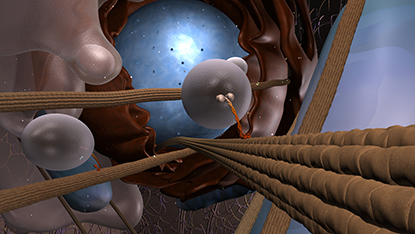Harnessing the Power of RNA Molecules
Studying the Function of Genes, One at a Time

CREDIT: NATIONAL CENTER FOR ADVANCING TRANSLATIONAL SCIENCES (NCATS)
No, those spheres aren’t the new planets recently discovered by NASA. They are illustrations of RNA-interference (RNAi) molecules, magnified thousands of times. Scientists have harnessed the power of RNAi to study the function of many individual genes by reducing their activity levels or silencing them. In genome-wide RNAi screens, robots are used to introduce small-interfering RNAs—which have a complementary sequence to that of a targeted gene—into human cells to block the activity of each gene, one at a time. While each gene is silenced, researchers look for changes in cell function to learn about what the gene normally does. This process can produce a complete list of genes involved in particular biological functions or diseases, an invaluable step in identifying potential drug targets.
The National Center for Advancing Translational Sciences (NCATS) runs a state-of-the-art RNAi screening facility that is open to NIH investigators. To find out how to collaborate with the NCATS RNAi program, go to https://ncats.nih.gov/rnai#learn-more.
This page was last updated on Monday, April 11, 2022
